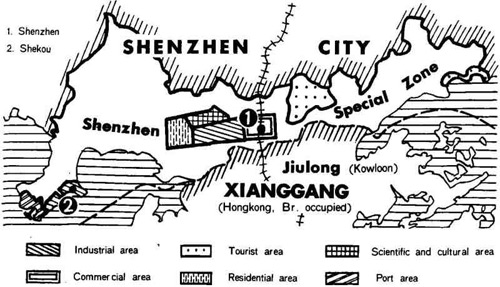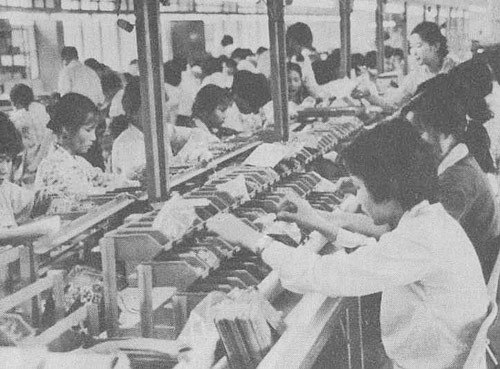|
The economy is developing by leaps and bounds. Gross industrial and agricultural output value has increased by a big margin, amounting to 240 million yuan (about $133 million), a 20 percent increase over 1979. Total output value this year is expected to be approximately 280 million yuan (about $155.5 million). Industry had an increased share, 45 percent in 1980. Financial revenue in 1980 was 56 percent greater than that of 1979. Financial revenue in the first half of this year was 3.9 time that of the same period in 1980.
Two other SEZs in Guangdong

The Zhuhai special zone, which is located opposite Macau, has an area of 6.8 square kilometres, 45 per cent of which is devoted to industry, 15 per cent to residences, 5 per cent to scientific research departments and the remainder to parks, schools, medical and health facilities and roads. The primary emphasis is on light and electronics industries as well as other trades which interest foreign businessmen.
Zhuhai city is developing a processing industry with materials from foreign businessmen, compensatory trade and co-operative enterprises. The Xiangzhou Woollen Mill is China's first compensatory trade factory. Between January and November 1980, Zhuhai city concluded 72 contracts with foreign businessmen. Numerous foreign consortiums and banks have expressed interest in setting up financial branches in the Zhuhai special zone. Some foreign businessmen have indicated that they want to invest in building a glassworks with an annual capacity of 5 million standard boxes of glass, an electronics centre and electrical appliance factories. Some businessmen are prepared to invest one billion each in Xianggang dollars to build two comprehensive construction projects consisting of residences, markets and factories.
The Shantou special zone was the one whose construction was started later than the other two special zones in Guangdong Province. According to the preliminary plan, this special zone comprises two processing districts and four companies: (1) The Longhu processing district. which is located in the southwest section of Longhu village on the outskirts of Shantou city. will eventually encompass 1.6 square kilometres. An area of 0.2 square kilometre has first been marked out for the construction projects; (2) the port area, with a planned total area of 1.7 square kilometres, is located in the south of Longhu village and east of the fishery port. where warehouses are to be built. The port district is responsible for packaging and shipping large numbers of local export goods, including artwork and ceramics; (3) integrated agricultural development company, with a total area of 10 square kilometres covering the outskirts of Shantou and part of Chenghai County. Vegetable, flower, tree, pig, fish, shrimp, chicken, duck and goose exporting bases are to be built here; some small experimental fields and seedling nurseries are planned to be set up first; (4) tourism company incorporates the Mayu Island and part of Chaoyang County as the tourist areas of the special economic zone. Houses and villas for tourists are to be built here; (5) the special economic zone development company; (6) the service company.
Existing enterprises in the urban areas of Shantou which primarily produce export goods can become, after transformation, enterprises of the special zone and enjoy its preferential treatment. Efforts are being devoted to the construction and installation of water and electrical facilities within the special zone.
The construction of the Xiamen special zone in Fujian Province on China's southeast coast was formally approved by the Central Government in October last year.
Xiamen. an island city, covers an area of 1,466 square kilometres. of which Xiamen proper takes up 123 square kilometres. Huli which is part of the special zone occupies an area of 2.5 square kilos.
Xiamen's climate is mild but humid. It has rich resources, a fairly good industrial foundation, natural harbours and good water, land and air transport services. It was one of the first trading ports opened in China during the mid-19th century. About 200,000 overseas Chinese residing abroad and Chinese with foreign citizenship are from Xiamen.
Huli is an exporting-processing industrial district in the Xiamen special economic zone. This district is to be constructed in two stages. During the first stage, efforts are concentrated on the construction of industrial buildings covering 1.1 square kilos, including ground levelling and the installation of water, electricity, transport and communications facilities. Factories (estimated at 160,000 square metres) and residential facilities are also under construction. At present, China is financing construction of this special zone, but foreign merchants are welcome to take part in its development. The second stage of the project will encompass an area of about two square kilos.
 |
|
The Guangming Electronics Factory, which will be developed into a comprehensive electronics company |
However, the Xiamen special economic zone is not confined within the 2.5 square kilos. All co-operative enterprises with foreign investment in Xiamen which primarily produce export goods can enjoy the special zone's preferential treatment.
Between 1979 and 1980, Xiamen concluded 103 contracts for processing materials and assembling machines for foreign countries. Service charges amounted to $900,000.
Four compensatory trade contracts were signed during the past two years, including eel breeding and a tin can production line in the Xiamen Canned Food Factory. Foreign businessmen have invested more than $1 million.
In order to induce foreign capital to transform Xiamen's existing industries and increase exports, 25 factories have been selected as the key units for developing economic cooperation with foreign countries. The agreements include joint ventures with Chinese and foreign investments, co-operative enterprises, processing industry with foreign materials and increasing exports with existing products. When each factory has completed its co-operative plan, the special zone will invite tenders. | 